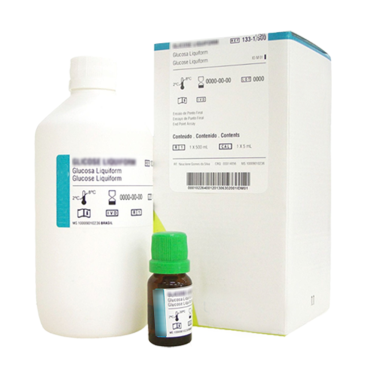Cromatest Magnesium Biochemistry Reagent
৳ 2,930৳ 3,200 (-8%)
In stock
Cromatest Magnesium Biochemistry Reagent
Packaging Size: ( 2×50 ) ml
Origin: Spain
Brand : Cromatest / Linear
Packaging Type: Bottle
Test/Pack: 100Test
Method: CALMAGITE Colorimetric method
Magnesium (Ready To Use)
PRINCIPLE:
The method1 is based on the specific binding of calmagite, a metallochromic indicator2, and magnesium at alkaline pH with the resulting shift in the absorbtion wavelength of the complex. The intensity of the cromophore formed is proportional to the concentration of magnesium in the sample.
Calmagite + Magnesium (pH 11.5 ) Calmagite-Magnesium complex.
REAGENT COMPOSITION:
Chromogen. Calmagite 75 mmol/L, EGTA 60 mmol/L, amin methyl-propanol 0.2 mol/L, KCl 0.2 mol/L, surfactant 0.05 % (w/v)
Magnesium standard. Magnesium 2 mg/dL (0.82 mmol/L) Organic matrix based primary standard.
STORAGE AND STABILITY: Store at 2-8ºC.
The Reagent and the Standard are stable until the expiry date stated on the label.
REAGENT PREPARATION:
The Monoreagent and the Standard are ready to use.
Discard the mixture if the blank presents an absorbance above
0.575 at 520 nm against distilled water (see Notes).
SAMPLES: Serum or heparinized plasma free of hemolysis. Other anticoagulants (EDTA, oxalate and citrate) must not be used.
Magnesium in serum or plasma is stable for 10 days at 2-8ºC. Frezze for longer storage

INTERFERENCES3
- Any substance which either chelates magnesium or contain magnesium will interfere with the
- Many detergents and water supplies are a major source of contamination of the glassware used for this
- The interference by calcium is prevented by the use of EGTA into the
- Lipemic samples (>0,5 g/dL)
- Bilirubin (>20 mg/dL) does not
MATERIALS REQUIRED:
Photometer or colorimeter capable of measuring absorbance at 520 ± 20 nm.
- Pipettes with disposable plastic tips to measure reagents and
- Disposable plastic tubes for the
PROCEDURE:
- Bring reagents and samples to room
- Pipette into labelled test tubes:
TUBES
Blank
Sample
Standard
Reagent – 10 mL – Sample – – 10 mL Standard 1.0 mL 1.0 mL 1.0 mL
- Mix and let stand the tubes 2 minutes at room
- Read the absorbance (A) of the samples and the standard at 520 nm against the reagent blank at 37ºC.
The color is stable for at least 1 hour.
CALCULATIONS:
Samples with concentrations higher than 5 mg/dL (2.06 mmol/L) should be diluted 1:2 with saline and assayed again. Multiply the results by 2. If results are to be expressed as SI units apply :mg/ dx 0.412 = mmol/L.
REFERENCE VALUES4
Serum, plasma
| Children (2-12 years) | 1.7-2.3 mg/dL (0.70-0.94 mmol/L) |
| Adults (12-60 years) | 1.6-3.0 mg/dL (0.66-1.23 mmol/L) |
It is recommended that each laboratory establishes its own reference range.
QUALITY CONTROL:
The use of a standard to calculate results allows to obtain an accuracy independent of the system or instrument used.
To ensure adequate quality control (QC), each run should include a set of controls (normal and abnormal) with assayed values handled as unknowns.
CLINICAL SIGNIFICANCE:
Magnesium is considered an essential nutrient and a major intracellular cation. More than 50% of the total magnesium found in the body is complexed with calcium in the skeleton; however, only 1% of total body magnesium is found in the circulation. Between 60% and 70% of serum magnesium is free; the remaining percentage is bound to albumin, phosphate, citrate, and other ions.
Magnesium is also used as an activator (inorganic ion that is needed as a cofactor for an enzyme reaction) for more 300 enzymes, especially those involved in oxidative phosphorylation, glycolysis, cell replication, and protein synthesis.
The absorption of magnesium in the intestinal tract and its reabsorption in the renal tubules are directly associated with the body´s need, balance and health.
Hypomagnesemia (an abnormal decrease in the level of serum magnesium) is usually associated with severe prolonged diarrea, impairment of neuromuscular function, gastrointestinal malabsorption and alcoholism.
Hypermagnesemia (an abnormal elevation in the level of serum magnesium) is usually associated with renal glomerular failure, dehydration, sever diabetic acidosis, and Addison´s disease.
NOTES:
- Most of the detergents and water softening products used in the labs contain quelating agents. A defective rinsing will invalidate the procedure. Keep the glassware acid washed and thoroughly rinsed at all
-
ANALYTICAL PERFORMANCE
- Linearity: Up to 5 mg/dL
- Precision:
mg/dL Within-run Between-run Mean 1.12 2.25 4.5 1.12 2.25 4.5 SD 0.03 0.04 0.04 0.038 0.038 0.051 CV% 2.7 1.8 0.9 3.4 1.7 1.2 N 10 10 10 10 10 10 - Replicates: 10 for each level. Instrument: CECIL CE 2021Replicates: 10 for each level for 8 daysSensitivity. Using a 1:100 sample/reagent at 520 nm, 1 mg o magnesium will produce a net absorbance of approximately 075.Correlation. This assay (y) was compared with a similar commerci method (x). The results were:N = 20 r = 0.985 y =0.972x + 0.006
-
REFERENCES:
- Lindstrom, F., and Anal. Chem. 32 : 1123 (1960).
- Anderegg, G, Flashka, , Sallmann, R. and Schwartzenbach,
- Metallindikatoren VII. Fasciculus: 37 : 113 (1954).
- Chauhan, P.S., and Sarkar, B.C.R. Anal. Biochem. 32:70 (1969).
- N.W. Clinical Guide to Laboratory Tests, 3rd Edition.
W.B. Saunders Co. Philadelphia, PA. (1995).
Brand
Chromatest
Linear
You must be logged in to post a review.







Reviews
There are no reviews yet.